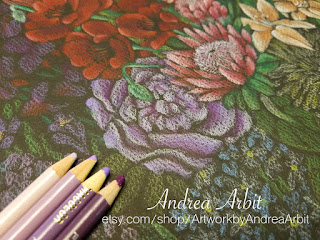When I say this drawing is a celebration of differences in sexuality, I'm including differences in libido, sexual behaviors, frequency, desire, willful abstinence, asexuality, sexual orientation, and relationships. For more discussion on sexuality (and definitions of related terminology), please visit this blog post.
For a description of the specific symbolism of the 24 flowers used in this drawing, check out this blog post.
-
It's time to look at the next six flowers in this bouquet - the second half of the orange section, and the purple section.
The next orange flowers I worked on were these zinnia plants. I used white and peach for highlights, yellow, orange-yellow, orange, and red pencils for the petals, and two shades of green for the leaves.
I rounded out the orange section with these pale orange lilies. I used white, peach, and orange pencils for the petals, and three shades of green for the leaves, and to blend into the little lily buds that hadn't opened yet.
I moved onto the purple section next, only because I'm a righty and used to working on artwork from left to right so as to avoid potential smearing or smudging. The purple section is the farthest to the left in this bouquet.
For the large purple peony, I used four shades of purple ranging from very pale lavender-gray to a darker red-violet pencil.
For the purple gladiolus, I used three shades of purple, black, and red (to help blend the purple section into the red section just a little bit). For the stems I used green and blue-green pencils.
The cute little crocuses were drawn with red-violet, black, yellow, green, and two light purple pencils.
The last purple flower was this bunch of hydrangea. Since it's adjacent to the blue section, I added some blue coloring in as well. I used pink, red-violet, purple, pale purple, light blue, dark blue, light green, and dark green colored pencils. The yellow-green pencil on the end is the one I used to add a few small leaves coming off the large peony blossom.
This second pass through of the bouquet is now half done! I've finished the red, orange, and purple sections. Next up - adding in some yellow!
For a description of the specific symbolism of the 24 flowers used in this drawing, check out this blog post.
-
It's time to look at the next six flowers in this bouquet - the second half of the orange section, and the purple section.
The next orange flowers I worked on were these zinnia plants. I used white and peach for highlights, yellow, orange-yellow, orange, and red pencils for the petals, and two shades of green for the leaves.
I rounded out the orange section with these pale orange lilies. I used white, peach, and orange pencils for the petals, and three shades of green for the leaves, and to blend into the little lily buds that hadn't opened yet.
I moved onto the purple section next, only because I'm a righty and used to working on artwork from left to right so as to avoid potential smearing or smudging. The purple section is the farthest to the left in this bouquet.
For the large purple peony, I used four shades of purple ranging from very pale lavender-gray to a darker red-violet pencil.
For the purple gladiolus, I used three shades of purple, black, and red (to help blend the purple section into the red section just a little bit). For the stems I used green and blue-green pencils.
The cute little crocuses were drawn with red-violet, black, yellow, green, and two light purple pencils.
The last purple flower was this bunch of hydrangea. Since it's adjacent to the blue section, I added some blue coloring in as well. I used pink, red-violet, purple, pale purple, light blue, dark blue, light green, and dark green colored pencils. The yellow-green pencil on the end is the one I used to add a few small leaves coming off the large peony blossom.
This second pass through of the bouquet is now half done! I've finished the red, orange, and purple sections. Next up - adding in some yellow!














No comments:
Post a Comment